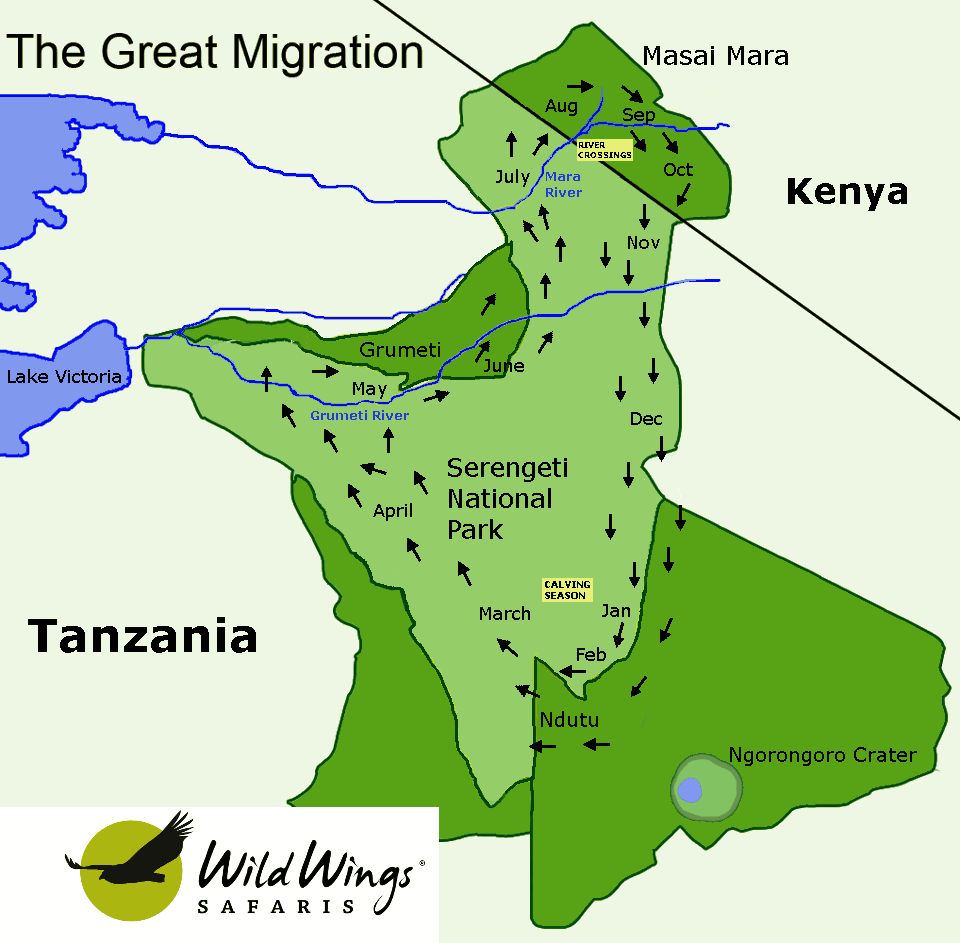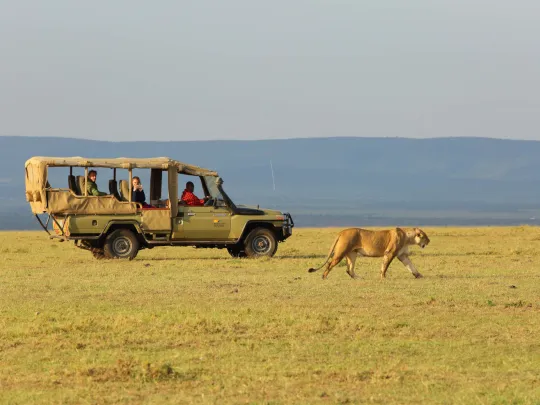The Great Wildebeest Migration: A Complete Guide
The Great Wildebeest Migration is an unrivalled wildlife spectacle that unfolds every year in Tanzania's Serengeti and Kenya's Masai Mara reserves. Triggered by the seasonal rains, around 1.5 million wildebeest, 200,000 zebra and hundreds of thousands of antelope migrate in search of fresh grazing grounds. Along the way, they make treacherous river crossings where crocodiles lie in wait and many fall prey to other predators like lions, leopards and cheetahs. But when do the river crossings take place and when is the best time to see the migration in action?
What Is the Great Wildebeest Migration?
Contrary to what many people think, the Great Wildebeest Migration doesn't only take place between July and September. This is when the nail-biting river crossings occur, which the migration is most famous for. Rather, the Great Migration is a year-round, ongoing mass movement of wildlife. Spurred on by the rains in East Africa, millions of wildebeest, zebra and antelope embark on a perilous quest to find good grazing and return to the southern plains of the Serengeti for the annual calving season.
The Wildebeest Migration Route: How It Works

Map of the Great Migration
The Great Migration takes place in the Serengeti-Mara ecosystem spanning Tanzania and Kenya. Moving roughly in a clockwise direction, the journey starts after the calving season in the Ndutu region of the Ngorongoro Conservation Area and the southern plains of the Serengeti National Park. The herds then make their way northwards and westwards toward the Grumeti region. After crossing the Grumeti River, they move further north towards Kenya's Maasai Mara National Reserve, which borders the Serengeti to the north. They cross several rivers along their journey, the most famous of which is the Mara River. The wildebeest stay in the Mara for a month or two before circling back south and migrating down to the fertile southern plains to give birth. And so their ancient journey begins anew.

Great Migration river crossings don't follow Swiss time
Trying to predict the exact timing of the animals' movements is tricky. If you book an East African safari in peak safari season between July and September in the hopes of witnessing one of the world-famous river crossings, there is no guarantee you'll get to see one. Nature is unpredictable, and there's no way to accurately forecast exactly where the herds will be, when the rains are going to arrive, or how long they're going to last. The rains may come early one year and late the next.
Even if you do happen to get the timing spot-on and you're perfectly positioned to watch a dramatic river crossing unfold before your eyes, the migration remains unpredictable. Sometimes, the mega herds stay congregated on the river banks for days before attempting a river crossing. Other times, the animals cross the river as soon as they arrive at the water. Nature dances to no one's tune.
For this reason, it's important to factor in as much time on safari as possible if your goal is to witness a river crossing. However, there's more to the Great Migration than river crossings. Calving season is an equally exciting part of this age-old migratory cycle. But the most important thing to know about the Serengeti and Masai Mara is that the resident game is so prolific and the wildlife sightings so rewarding that you can go on safari any time of year, even outside migration season, and still have excellent game viewing.
Timing the Migration: A Month-by-Month Breakdown
The Serengeti and Masai Mara's beautiful scenery and thriving wildlife make them incredibly rewarding safari destinations all year round, even outside migration season. That said, if it's a Great Migration safari you're after, here's a general guide of what tends to happen when:
October to December

There's plenty of resident game in the Serengeti and Masai Mara all year round
The start of the short rains in October sends the wildebeest southwards. Driven by the ever-present need to search out fresh grounds for grazing, the wildebeest leave Kenya's Masai Mara and cross into Tanzania's Serengeti.
Don't underestimate how rewarding a safari in the Masai Mara can be during the short rains. Dramatic thunderstorms in the afternoons often present spectacular photographic opportunities, migratory birds arrive in droves, and the resident wildlife provides ample game-viewing opportunities, without the crowds of peak season.
While you're sure to spot some stragglers in the Mara come December, by then, most of the migratory wildebeest are flooding the vast plains of central and eastern Serengeti in large numbers as they journey southwards.
January and February

February is wildebeest calving season in Ndutu
The Southern Serengeti and Ndutu Region in Tanzania are the best places to be in January and February. It's one of the warmest times of the year with daytime temperatures reaching 30°C, it falls between the short and long rains, and the chances of witnessing some thrilling predator action are extremely good.
That's because it's calving season.
The wildebeest congregate en masse on the lush green plains of southern Serengeti and the Ndutu region of the Ngorongoro Conservation Area, where 80% of the females in the herd give birth to over 8,000 wildebeest calves every day within the same two- to three-week period. The sudden availability of vulnerable and easy-to-target prey attracts the Serengeti's big cats, roving packs of African wild dogs, resident hyena clans and the occasional opportunistic jackal, which provides safari-goers with some spectacular, action-packed game viewing opportunities.
Your best chance of witnessing the birth of a wildebeest calf or spotting a calf that's just a few hours old is usually around noontime when most predators are seeking a respite from the midday sun. This is nature's way of providing newborn calves enough time to learn how to stand on their wobbly legs and gain strength before late afternoon, which is when most predators tend to go on the prowl.
March and April

Dramatic storm clouds gather during the rainy season
It might take mere minutes for wildebeest newborns to learn to stand, but it takes a couple of weeks before the calves are strong enough to join the herds on the next noisy and chaotic leg of their odyssey, which usually begins in March or April. If you're not put off by the occasional afternoon rain shower, the best place to see the herds gathering in ever-growing numbers is in the southwest of the Serengeti National Park.
The long rains usually arrive in March or April and drive the herds in a northwesterly direction. Many camps in southern Tanzania close on account of the heavy rainfall, which makes the roads slippery and the terrain difficult to navigate, even in a 4x4.
Some safari lodges, however, remain open because April and May are still good times to go on safari. Room rates are lower, visitor numbers drop, and the dramatic thunderclouds and spectacular sunsets are a photographer's dream. The long rains usher in the start of the wildebeest rutting season. This is when wildebeest bulls, fuelled by testosterone, battle one another for the right to mate. These noisy and sometimes surprisingly violent battles for dominance continue well into May.
May and June

Wildebeest columns traversing the Northern Serengeti
As the long rains continue into May, the pace at which the wildebeest are moving begins to pick up now that the calves are older and stronger. Up to 40-kilometre-long (25 miles) columns of wildebeest, zebra and sometimes Thomson's and Grant's gazelles snake their way northwards through the central Serengeti, bringing them closer to their next big challenge: the Grumeti River.
While the Grumeti River can and does provide some nail-biting wildlife drama, viewing opportunities are fewer, and the Mara River crossings tend to be more spectacular. The Grumeti River has less water than the Mara River, so the wildebeest can cross the river at any number of points, which makes it extremely difficult to predict where crossings might take place.
The end of the long rains in June marks the start of peak safari season in Tanzania, and the Seronera, Grumeti Reserve and northern Serengeti see an increase in visitors hoping to catch a glimpse of the migratory herds as they press on northwards. Once again, the timing of the Gnu Migration is different from year to year and is dependent on the pattern of rainfall. Mobile safari camps move with the herds and are a fantastic option if you want to get as close to the Great Migration as possible.
July and August

Chaotic Mara River crossing
The onset of the southern hemisphere winter in July brings sunshine, blue skies and pleasant daytime highs of 26°C to East Africa. Pack some warm clothing, though. While July is Serengeti's driest month, it's also the coolest. Early morning and evening game drives in temperatures that average 14°C or less can be brisk if you're not dressed warmly enough.
Having survived the dangers of the Grumeti River in the northwest of Serengeti National Park, the wildebeest now face their most daunting challenge yet: the treacherous Mara River crossing in the Northern Serengeti, before the herds head into Kenya's Masai Mara.
Witnessing the chaotic frenzy of a Mara River crossing is one of East Africa's most spectacular safari experiences. As thousands of wildebeest and zebra brave the dangerous waters, some fall prey to gigantic Nile crocodiles, some drown in the frantic race to get to the other side of the river, and others are snatched by predators lurking on the riverbanks.
Once again, even though the wildebeest have historical crossing areas, trying to accurately predict a river crossing is impossible. To maximise the chances of seeing a crossing on your Great Wildebeest Migration safari, we recommend you book accommodation at a safari lodge reasonably close to the Mara River. The further away your safari lodge is from an expected crossing point, the more distance you have to cover to reach the crossing point. By the time you arrive at the lookout point, you may discover that other vehicles have already staked out all the prime viewing positions. Keep in mind that safari lodges with quick and easy access to the river book out fast, so you'll have to plan your migration safari at least one year in advance.
River crossings often start in late July in northern Tanzania, and continue well into September and sometimes early October in the Mara. July to September is the peak season for migration safaris.
September and October

The Mara can get crowded in peak safari season from August to September
September sees gigantic herds of wildebeest grazing their way through Kenya's Maasai Mara National Reserve. Come October, when the short rains arrive, they are ready to begin migrating back down into the Serengeti, where the cycle begins anew. August and September are extremely busy months in the Mara. The weather is fantastic, there is almost no rainfall, and the dry season game viewing conditions make it easy to spot game. And did we mention the river crossings? Be prepared for crowds and premium safari lodge rates.
If you're looking for a more intimate safari experience away from the masses, consider staying at one of the private conservancies that border the Maasai Mara National Reserve. From there, you can make a day trip into the Mara to see the herds and, with some luck, a river crossing, while still enjoying uncrowded game drives back at camp. Another way to avoid the crowds is to visit the Mara outside migration season in October or November during the short rains instead. You may miss the drama of a river crossing, but you'll pay less for accommodation and have plenty of phenomenal wildlife sightings all to yourself without the crowds.
Planning a Migration Safari: What You Need to Know

Predators face struggles of their own in the wild
It's easy to see why the annual mass migration of millions of wildebeest and scores of zebra on the vast plains of East Africa is often called The Greatest Show on Earth. Even if you've seen wildlife footage of a river crossing, nothing can really prepare you for the full impact of the drama unfolding in the flesh.
The frantic sound of thundering hooves and churning water. The frenzied sight of hoards of wildebeest urgently trying to get to dry land on the other side of the river. The terrifying odds of falling prey to crocodiles lying submerged in the water and big cats lurking in the riverine shrubs, waiting for the right moment to strike.
The bittersweet wonder of calving season on the southern plains of the Serengeti and Ndutu region in Tanzania in February is equally dramatic. The sight of newborn wildebeest calves trying to stand on shaky legs. Lions, who face their own harsh struggles to survive, waiting to ambush them.
We've been privileged to witness the one-of-a-kind experience only the Great Wildebeest Migration can offer, and we can safely say that if a Serengeti or Masai Mara migration safari is not on your bucket list, it should be.
Now that you know there's more to the Great Wildebeest Migration than river crossings and that the animals' movements are guided by the rains, where you go and when you go on safari depends on which events you'd like to witness.

The Great Wildebeest Migration in a nutshell
Top Tips for Planning Your Great Migration Safari
Whether you're hoping to witness a dramatic river crossing or the spectacle of calving season, timing and logistics are key. These expert tips will help you get the most out of your Great Migration safari experience.
The Great Migration is one of Africa's most sought-after wildlife events, especially during peak moments like the Mara River crossings (July–September) and the calving season in Ndutu (January–February). Safari lodges and mobile camps in prime locations tend to book out a year in advance, especially those with river access. Booking early gives you the best chance of securing a well-located camp and experienced guides, ensuring you're in the right place at the right time.
Location is everything when it comes to seeing the migration. Camps in the Northern Serengeti or Masai Mara offer the best chances to witness river crossings from July to September, while Ndutu and the Southern Serengeti are ideal for calving season. Avoid the trap of booking based on lodge luxury alone — a well-situated tented camp will deliver a far richer safari experience if it puts you close to the action.
If you'd prefer a quieter safari experience without sacrificing wildlife quality, consider staying in a private conservancy bordering the Masai Mara. These areas offer excellent game viewing, off-road driving, night drives, and fewer vehicles — all while contributing directly to community and conservation efforts. From here, you can still visit the Mara for a day to see the migration, then return to more peaceful surroundings.
Mobile camps are seasonal tented camps that move with the migration, placing you close to the herds wherever they are. These camps offer an authentic, immersive safari experience — often with fewer guests and expert guiding. They're a fantastic option for those wanting flexibility and a front-row seat to the ever-shifting drama of the Great Migration.
Ready to Plan Your Great Migration Safari?
If you're keen to experience a Great Migration safari, contact us for a free quote. Remember to let us know when you'd like to travel and what part of the migration you'd like to experience.
You may also want to look at

5 Day Luxury Serengeti Safari
Explore one of the Serengeti's most exclusive regions on this 5-day luxury fly-in safari. Based at Olmara Camp in the Soit le Motonyi area of eastern Serengeti, you'll experience exceptional game viewing in a remote, low-tourist zone known for its high concentration of big cats. This safari includes a scenic domestic flight from Kilimanjaro International Airport near Arusha to Seronera Airstrip in the central Serengeti, four nights in an eco-luxury tented camp, and expertly guided game drives in a wildlife-rich area once closed to tourists.

6 Day Masai Mara Wildlife Safari – Big Game. Big Views. Big Value.
This 6-day wildlife safari offers serious game viewing in the heart of one of Africa's best-known reserves. It includes a night in Nairobi and four nights at Entim Camp – a luxury tented camp overlooking the Mara River, known for outstanding Big Five sightings and its front-row seat to the Great Migration (in season). With expert local guides and unlimited game drives, this small-group safari is perfect for wildlife enthusiasts and photographers seeking immersive safari experiences without the luxury price tag.

6 Day Masai Mara Budget Safari – An Affordable Adventure
Looking for the best Masai Mara safari without breaking the bank? This 5-night Masai Mara safari offers incredible Big Five game viewing in one of Africa's most iconic reserves—at an affordable price. Stay in a comfortable en-suite tented camp along the Talek River, where wildlife roams freely. Enjoy flexible game drives in Masai Mara National Reserve, guided by expert local guides. Whether you're after an affordable Masai Mara experience or a private Kenya budget safari, this trip delivers unbeatable value.
About the author

Dianne Kokkonidis was born in Johannesburg, grew up in the Transkei and spent years exploring Europe. She returned to South Africa to live on a farm in the Outeniqua Mountains when the call of Africa got too loud to ignore. She comes from a family of storytellers, so it's no surprise she's now found her way into writing about one of the oldest stories known to mankind - the lure of Africa.









